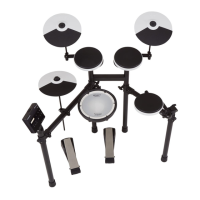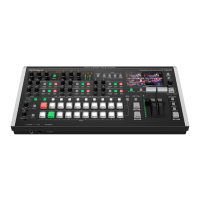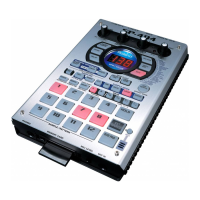5
DRUM KIT
PAD MIDI (page 4)
Parameter Value Explanation
NOTE tab
Note No.
0(C -)–127(G 9) MIDI note number transmitted and received by each pad
OFF Note messages are not transmitted or received
GATE tab
Gate Time 0.1– 8.0 s Duration of the note transmitted by each pad
MIDI CH tab
MIDI Channel
CH1–CH16 MIDI channel on which each pad transmits or receives note messages or control change messages
GLOBAL Transmitted and received on the transmit/receive channel specied in SETUP (p. 32)
MIDI note numbers transmitted and received by the hi-hat
Item Explanation
HI-HAT OPEN <BOW>
HI-HAT OPEN <EDGE>
MIDI note number transmitted and received by open hi-hat (bow, edge)
HI-HAT CLOSE <BOW>
HI-HAT CLOSE <EDGE>
MIDI note number transmitted and received by closed hi-hat (bow, edge)
HI-HAT PEDAL MIDI note number transmitted and received by pedal hi-hat
MIDI note numbers transmitted and received by the snare
Parameter Explanation
SNARE <HEAD>
SNARE <RIM>
MIDI note number transmitted and received by head shot and rim shot
SNARE <BRUSH> MIDI note number transmitted and received by brush sweep
SNARE <XSTICK> MIDI note number transmitted and received by cross stick
When setting multiple pads to the same note number
When playing the internal sound generator of the TD-50, if an incoming note number is assigned to more than one pad, that note plays the
instrument of the pad with the lowest trigger input number. If the same note number is assigned to both the head and the rim, the head instrument
is sounded.
MEMO
An asterisk (*) appears at the right of the note number for trigger inputs that are not sounded.
Example:
Note number “38 (D 2)” is set for the head and rim of trigger input 2 SNARE and the head of trigger input 3 TOM 1. In this case, when note number 38
(D2) is received, the instrument assigned to the head of trigger input 2 SNARE is played.
About the gate time
Percussion sound modules normally produce sound only in response to “Note on” messages, and ignore “Note o” messages. However general-
purpose sound modules or samplers do receive the note-o messages that are transmitted and respond by turning o the sound.
Since gate time is normally not necessary for a percussion sound module, this is set to the minimum value when the unit is shipped from the
factory. If a note-o message is received while the sound module has this setting, it is received as an extremely brief note that has almost no
time to be heard, and is nearly inaudible. (Alternatively, it is possible that this could be heard as an unwanted noise.) To avoid this, specify the
note duration of the MIDI performance data that is produced when you strike each pad.
* If the same note number is sounded again in an overlapping manner, a note-o is transmitted before transmitting note-on, even if it is
within the gate time.

